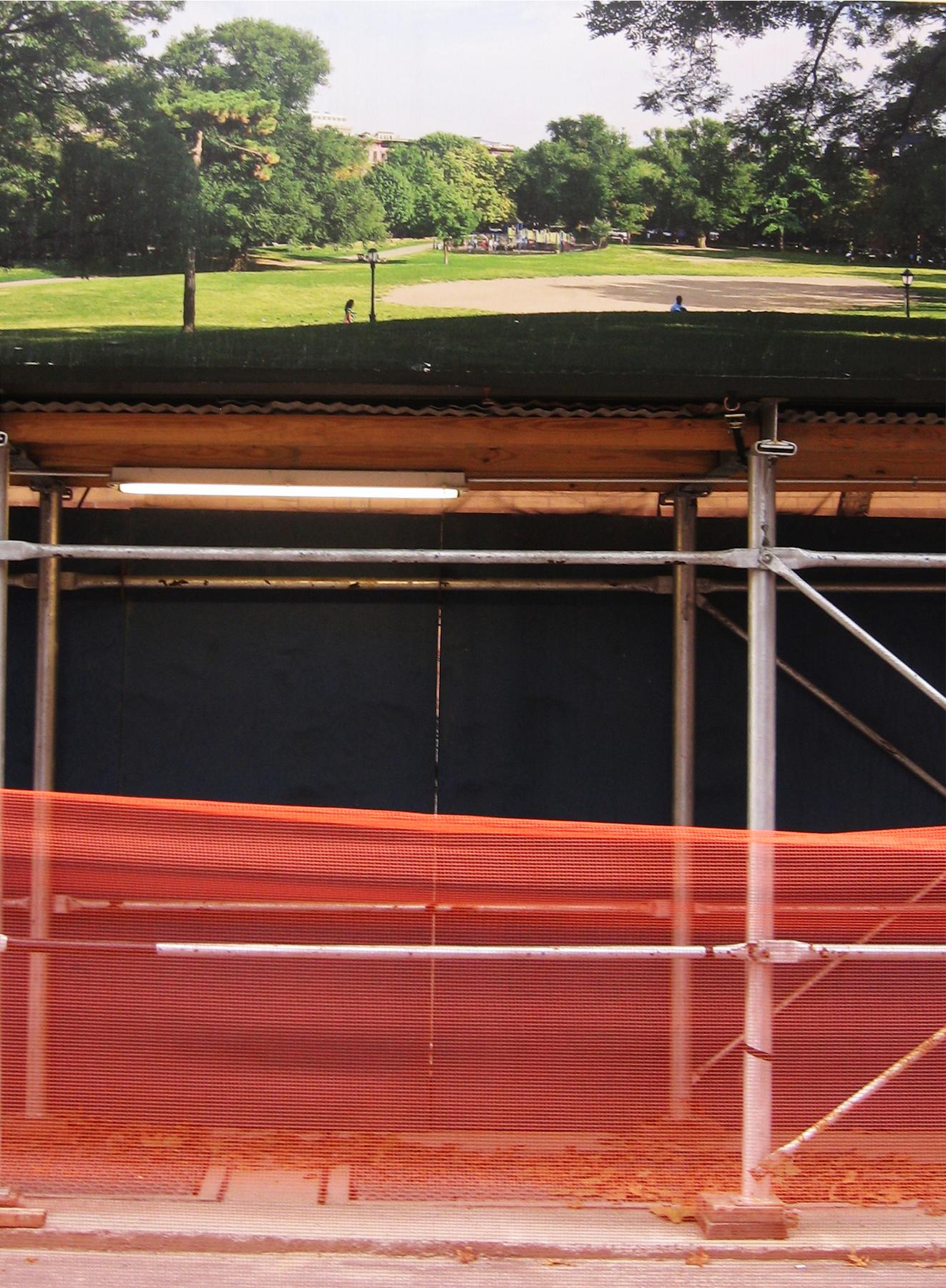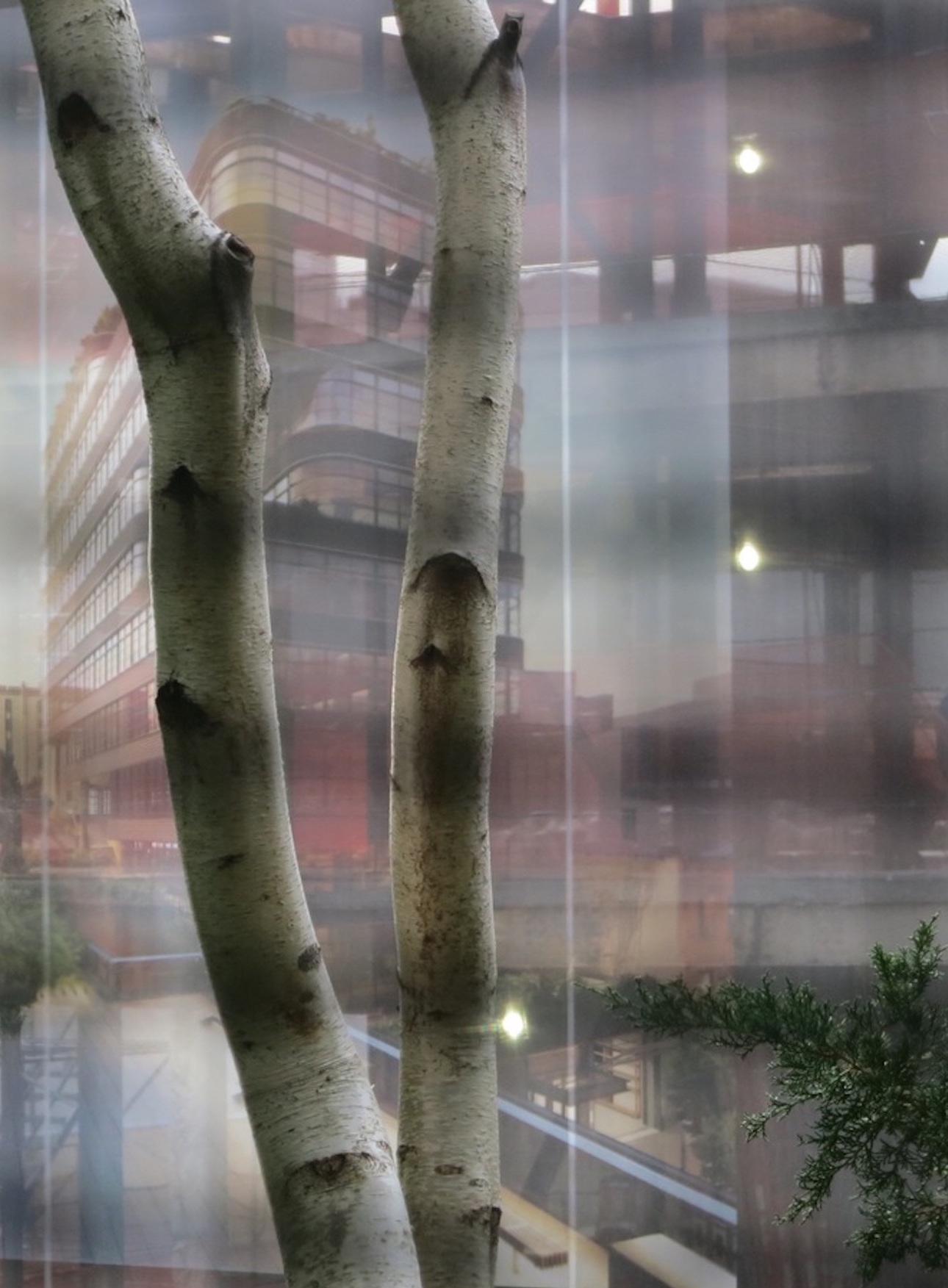Peter Scott



Arcadias, 2020, my installation for the Queens Museum facade’s park-facing windows includes a kind of trompe l’oeil image of a city park used to advertise a luxury condo. I was struck by the appropriation of an image of a public park as an advertisement for private property. Offering outdoor recreational space as an amenity to luxury condo-dwellers in a “transitioning” neighborhood, the ad signals a position of entitlement to publicly shared space that is based on financial rather than community interest.
A few years ago, I came across a video that provides a disturbingly accurate metaphor for the causal links between entitlement and displacement. The cell phone footage documents a confrontation on a soccer field in San Francisco’s Mission District, over long-standing codes regarding the playground pick-up game. The first player to arrive at the field while a game is in progress gets “next” and has the right to pick a team that will play the winners. The team is assembled as new players arrive. If there are not enough players when the next game is set to begin, players are chosen from the team that lost the last game. The playground pick-up game precludes any kind of favoritism or commercial incentive. There’s a ball that everyone shares and a set of agreed-upon rules. No referees, no outside adjudication. In an urban situation territorialized by skyrocketing land values, the shared courts found in every city neighborhood contradict the sense of privatization “closing in on” communities.
The video begins when a group of Dropbox and Airbandb tech workers show up and claim they’ve “booked the field” through an app (for which no signage is posted at the field itself). Detached from their surroundings (as the argument escalates one of them shouts “who gives a shit about the neighborhood!”) they unwittingly (and arrogantly) insert themselves into an urban ecosystem based on shared principles, which they’re unable to fathom. Invested in a digital libertarianism that promotes a technological “efficiency culture” over locality and in person experience, they seem oblivious to their own privilege, and quite unaware of the displacement that might take place as a result of their arrival in the community.
This same privileging of technology is addressed in Jacques Tati’s film Playtime, 1967, which offers a sharp critique of the ways in which design is employed to insulate the user, giving one a sense of mastery over “real life.” Playtime was filmed on a massive outdoor set and has a synthetic quality that parallels the simulated, hermetic nature of lifestyle culture ads for “modern urban living” found in today’s gentrifying neighborhoods. The glass curtain wall, typically associated with modernism’s International Style office buildings, in this case functions as a display window behind which the bourgeois family confidently expresses its private life to (be envied by) the public.
Tati’s absurd premise, which has families stacked on top of one another behind large panes of glass as in a department store, collapses distinctions between consumption and domestic life. Watching the families from the street (buses and traffic noise can be heard) we are invited to consume a mise en scene of domestic privacy. As the scene is projected out to the street, we become spectators to models of “proper” behavior framed within the windows. Identifying the urge to offer one’s life as display with a boundless right to consume, as Tati’s everyman character Houlot looks on, his host brings him up to the plate glass window and makes sweeping gestures to the left and right, as if indicating ownership of all that can be seen.
The lifestyle imagery that can be found posted on plywood fencing around luxury condo construction sites are similarly invested in the culture of entitlement and envy (a luxury condo on Willamsburg’s North 5th street was cleverly named NV). Written over with graffiti, these ads are the source of my photographs for the galleries at Queens Museum. As condo designs adopt a proto-modernist aesthetic employing glass curtain walls that echo Tati’s Playtime parody, the imagery that helps deploy them pushes a hermetic existence that expresses urban life as one of possession rather than engagement. But like the unfortunate tech workers who fail to realize that their apps cannot be seamlessly grafted onto the urban fabric, the tagging of these ads (“NO ONE CAN AFFORD THIS, Go Away”) indicates that not everyone is hypnotized by the perennial seductions of lifestyle culture. Given the significant changes now taking place within the urban landscape, it’s anybody’s guess as to its future viability.



Peter Scott is an artist, writer, curator, and director of the non-profit gallery carriage trade. He has exhibited his artwork internationally at institutions including Société, Brussels, Belgium; Pavillon de l’Arsenal, Paris, France, and Riverside Studios in London, England, among others. His work has been exhibited in New York at Magenta Plains, White Columns, The Brooklyn Museum, The Emily Harvey Foundation, and Marianne Boesky Gallery, among other venues. Recent exhibitions include Future City at the Suburban in Milwaukee Wisconsin, and Front International: Cleveland Triennial for Contemporary Art in Cleveland, Ohio. His writing and interviews on art and culture have appeared in Artforum, The Brooklyn Rail, Art Monthly, Art Critical, artnet, Artscribe, Made in U.S.A., as well as several exhibition catalogs. Scott currently lives and works in New York City.
Peter Scott



Arcadias, 2020, my installation for the Queens Museum facade’s park-facing windows includes a kind of trompe l’oeil image of a city park used to advertise a luxury condo. I was struck by the appropriation of an image of a public park as an advertisement for private property. Offering outdoor recreational space as an amenity to luxury condo-dwellers in a “transitioning” neighborhood, the ad signals a position of entitlement to publicly shared space that is based on financial rather than community interest.
A few years ago, I came across a video that provides a disturbingly accurate metaphor for the causal links between entitlement and displacement. The cell phone footage documents a confrontation on a soccer field in San Francisco’s Mission District, over long-standing codes regarding the playground pick-up game. The first player to arrive at the field while a game is in progress gets “next” and has the right to pick a team that will play the winners. The team is assembled as new players arrive. If there are not enough players when the next game is set to begin, players are chosen from the team that lost the last game. The playground pick-up game precludes any kind of favoritism or commercial incentive. There’s a ball that everyone shares and a set of agreed-upon rules. No referees, no outside adjudication. In an urban situation territorialized by skyrocketing land values, the shared courts found in every city neighborhood contradict the sense of privatization “closing in on” communities.
The video begins when a group of Dropbox and Airbandb tech workers show up and claim they’ve “booked the field” through an app (for which no signage is posted at the field itself). Detached from their surroundings (as the argument escalates one of them shouts “who gives a shit about the neighborhood!”) they unwittingly (and arrogantly) insert themselves into an urban ecosystem based on shared principles, which they’re unable to fathom. Invested in a digital libertarianism that promotes a technological “efficiency culture” over locality and in person experience, they seem oblivious to their own privilege, and quite unaware of the displacement that might take place as a result of their arrival in the community.
This same privileging of technology is addressed in Jacques Tati’s film Playtime, 1967, which offers a sharp critique of the ways in which design is employed to insulate the user, giving one a sense of mastery over “real life.” Playtime was filmed on a massive outdoor set and has a synthetic quality that parallels the simulated, hermetic nature of lifestyle culture ads for “modern urban living” found in today’s gentrifying neighborhoods. The glass curtain wall, typically associated with modernism’s International Style office buildings, in this case functions as a display window behind which the bourgeois family confidently expresses its private life to (be envied by) the public.
Tati’s absurd premise, which has families stacked on top of one another behind large panes of glass as in a department store, collapses distinctions between consumption and domestic life. Watching the families from the street (buses and traffic noise can be heard) we are invited to consume a mise en scene of domestic privacy. As the scene is projected out to the street, we become spectators to models of “proper” behavior framed within the windows. Identifying the urge to offer one’s life as display with a boundless right to consume, as Tati’s everyman character Houlot looks on, his host brings him up to the plate glass window and makes sweeping gestures to the left and right, as if indicating ownership of all that can be seen.
The lifestyle imagery that can be found posted on plywood fencing around luxury condo construction sites are similarly invested in the culture of entitlement and envy (a luxury condo on Willamsburg’s North 5th street was cleverly named NV). Written over with graffiti, these ads are the source of my photographs for the galleries at Queens Museum. As condo designs adopt a proto-modernist aesthetic employing glass curtain walls that echo Tati’s Playtime parody, the imagery that helps deploy them pushes a hermetic existence that expresses urban life as one of possession rather than engagement. But like the unfortunate tech workers who fail to realize that their apps cannot be seamlessly grafted onto the urban fabric, the tagging of these ads (“NO ONE CAN AFFORD THIS, Go Away”) indicates that not everyone is hypnotized by the perennial seductions of lifestyle culture. Given the significant changes now taking place within the urban landscape, it’s anybody’s guess as to its future viability.



Peter Scott is an artist, writer, curator, and director of the non-profit gallery carriage trade. He has exhibited his artwork internationally at institutions including Société, Brussels, Belgium; Pavillon de l’Arsenal, Paris, France, and Riverside Studios in London, England, among others. His work has been exhibited in New York at Magenta Plains, White Columns, The Brooklyn Museum, The Emily Harvey Foundation, and Marianne Boesky Gallery, among other venues. Recent exhibitions include Future City at the Suburban in Milwaukee Wisconsin, and Front International: Cleveland Triennial for Contemporary Art in Cleveland, Ohio. His writing and interviews on art and culture have appeared in Artforum, The Brooklyn Rail, Art Monthly, Art Critical, artnet, Artscribe, Made in U.S.A., as well as several exhibition catalogs. Scott currently lives and works in New York City.